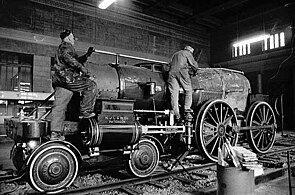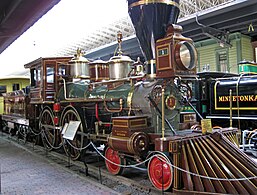
The Great Northern Railway was an American Class I railroad. Running from Saint Paul, Minnesota, to Seattle, Washington, it was the creation of 19th-century railroad entrepreneur James J. Hill and was developed from the Saint Paul & Pacific Railroad. The Great Northern's route was the northernmost transcontinental railroad route in the U.S.

A tender or coal-car is a special rail vehicle hauled by a steam locomotive containing its fuel and water. Steam locomotives consume large quantities of water compared to the quantity of fuel, so their tenders are necessary to keep them running over long distances. A locomotive that pulls a tender is called a tender locomotive. Locomotives that do not have tenders and carry all their fuel and water on board the locomotive itself are called tank locomotives or tank engines.

Under the Whyte notation for the classification of steam locomotives, 4-8-4 represents the wheel arrangement of four leading wheels on two axles, eight powered and coupled driving wheels on four axles and four trailing wheels on two axles. The type was first used by the Northern Pacific Railway, and initially named the Northern Pacific, but railfans and railroad employees have shortened the name since its introduction. It is most-commonly known as a Northern.

The Minnesota Transportation Museum is a transportation museum in Saint Paul, Minnesota, United States.

Milwaukee Road 261 is a class "S3" 4-8-4 "Northern" type steam locomotive built by the American Locomotive Company (ALCO) in Schenectady, New York in July 1944 for the Milwaukee Road (MILW). It was used for heavy mainline freight and passenger work until being retired by the MILW in 1956.

Saint Paul Union Depot is a historic railroad station and intermodal transit hub in the Lowertown neighborhood of Saint Paul, Minnesota. It serves light rail, intercity rail, intercity bus, and local bus services.

The Louisville and Nashville Railroad, commonly called the L&N, was a Class I railroad that operated freight and passenger services in the southeast United States.

The St. Louis–San Francisco Railway, commonly known as the "Frisco", was a railroad that operated in the Midwest and South Central United States from 1876 to November 21, 1980. At the end of 1970, it operated 4,547 miles (7,318 km) of road on 6,574 miles (10,580 km) of track, not including subsidiaries Quanah, Acme and Pacific Railway and the Alabama, Tennessee and Northern Railroad; that year, it reported 12,795 million ton-miles of revenue freight and no passengers. In 1980 it was purchased by and absorbed into the Burlington Northern Railroad. Despite its name, it never came close to San Francisco.

Western & Atlantic Railroad #3 General is a 4-4-0 "American" type steam locomotive built in 1855 by the Rogers, Ketchum & Grosvenor in Paterson, New Jersey for the Western & Atlantic Railroad, best known as the engine stolen by Union spies in the Great Locomotive Chase, an attempt to cripple the Confederate rail network during the American Civil War. Today, the locomotive is preserved at the Southern Museum of Civil War and Locomotive History in Kennesaw, Georgia, and is listed on the National Register of Historic Places.

A motive power depot (MPD) or locomotive depot, or traction maintenance depot (TMD), is where locomotives are usually housed, repaired and maintained. They were originally known as "running sheds", "engine sheds" or just "sheds". Facilities are provided for refuelling and the replenishing of water, lubricating oil and grease and, for steam engines, the disposal of ash. There are often workshops for day-to-day repairs and maintenance, but locomotive building and major overhauls are usually carried out at locomotive works.

The St. Paul and Duluth Railroad, a railroad in Minnesota and Wisconsin, operated independently from 1877, when it was reorganized from the Lake Superior and Mississippi Railroad, until 1900, when it was bought by the Northern Pacific Railway. It was nicknamed named the "Skally Line", likely based upon the Anglicization of the Swedish word "skulle", meaning "would." Many Swedish immigrants "would" take the line, which ran from Saint Paul to Duluth, Minnesota, and had branches to the Minnesota destinations of Minneapolis, Taylors Falls, Kettle River and Cloquet; and the Wisconsin destinations of Grantsburg and Superior.

The Eureka Springs & North Arkansas Railway is a for-profit passenger tourist railway established by the late Robert Dortch, Jr. and his wife Mary Jane in 1981 in Eureka Springs, Arkansas. The railway offers one-hour excursion tours, a catered luncheon train and a catered dinner train - each lasting a little more than one hour, from April through October. It operates along 2.5 miles (4.0 km) of restored track right-of-way formerly belonging to the defunct Arkansas & Ozarks Railway Co - the last incarnation of the North Arkansas Line.

Great Northern Railway 1355 is a standard gauge steam railway locomotive built by Baldwin Locomotive Works in 1909 for the Great Northern Railway in the United States. It was built as a 4-6-0, Ten-Wheeler, type, but it had an extensive rebuild in 1924 when it became a 4-6-2, Pacific, type. During its career, it pulled both freight and passenger trains, including the Great Northern's crack Empire Builder and Oriental Limited.

Great Northern 400, nicknamed Hustle Muscle, is a restored SD45 diesel locomotive originally owned by the Great Northern (GN). It was built in 1966 as the first production SD45 by Electro-Motive Division.

Great Northern 2584 is a 4-8-4 "Northern" type steam locomotive built by the Baldwin Locomotive Works in Philadelphia, Pennsylvania in March 1930 for the Great Northern Railway (GN) as a member of the S-2 class.

The Great Northern S-2 was a class of 14 4-8-4 "Northern" type steam locomotives built by the Baldwin Locomotive Works in 1930 and operated by the Great Northern Railway until the late 1950s.

The Great Northern P-2 was a class of 28 4-8-2 "Mountain" type steam locomotives built by the Baldwin Locomotive Works in 1923 and operated by the Great Northern Railway until the late 1950s.

Great Northern 2507 is a 4-8-2 "Mountain" type steam locomotive, a member of the P-2 class. Built for passenger service, the locomotive was assigned to pull the Great Northern's mainline passenger trains such as the Empire Builder and Oriental Limited, until being retired in December 1957 and sold to Spokane, Portland and Seattle Railway. GN 2507 is one of only two surviving examples of a P-2 class locomotive and, since 2003, has been on display at Wishram station in Wishram, Washington.

The St. Louis–San Francisco class 4500 was a class of 25 4-8-4 "Northern" type steam locomotives built by the Baldwin Locomotive Works between 1942-1943 and operated by the St. Louis–San Francisco Railway.

Spokane, Portland and Seattle Railway No. 539 is the only preserved example of the class O-3 2-8-2 "Mikado" steam locomotive. It was built by the American Locomotive Company in 1917 for the Northern Pacific Railway as engine No. 1762. It was sold to the Spokane, Portland and Seattle Railway and renumbered 539, in August 1944. It was reconfigured and converted to oil burning in January 1946. The locomotive was retired in 1957, and it was displayed in Esther Short Park, Washington, until 1997. That year, it was moved to Battle Ground for a potential restoration that never came to fruition. In 2007, it was acquired by the Grand Canyon Railway and moved to Williams, Arizona for an operational restoration that also never came to fruition. In 2019, No. 539 was purchased again by the Port of Kalama, who moved it back to Washington and put it on static display inside the Port's Interpretive Center that was constructed in 2014.




























